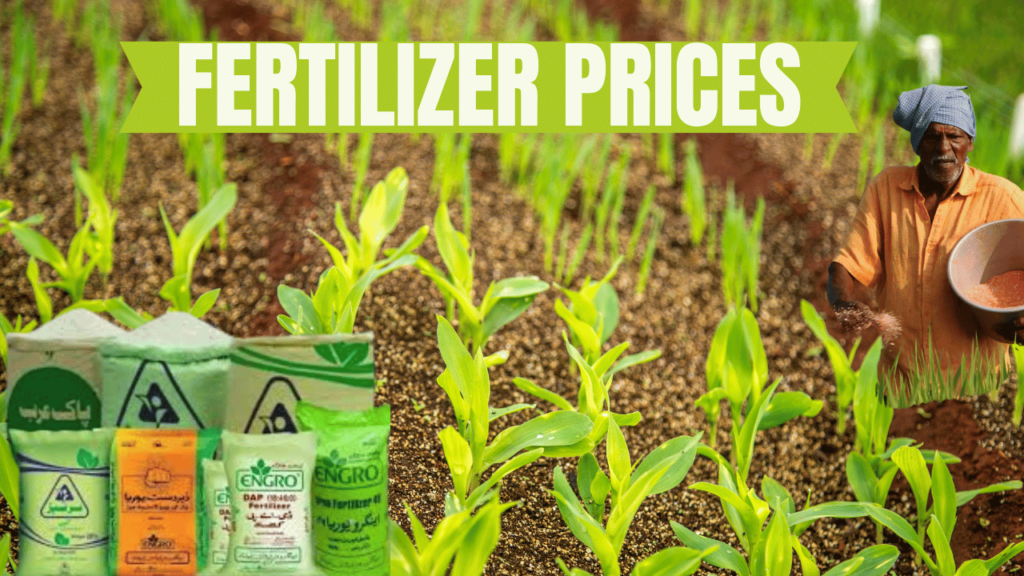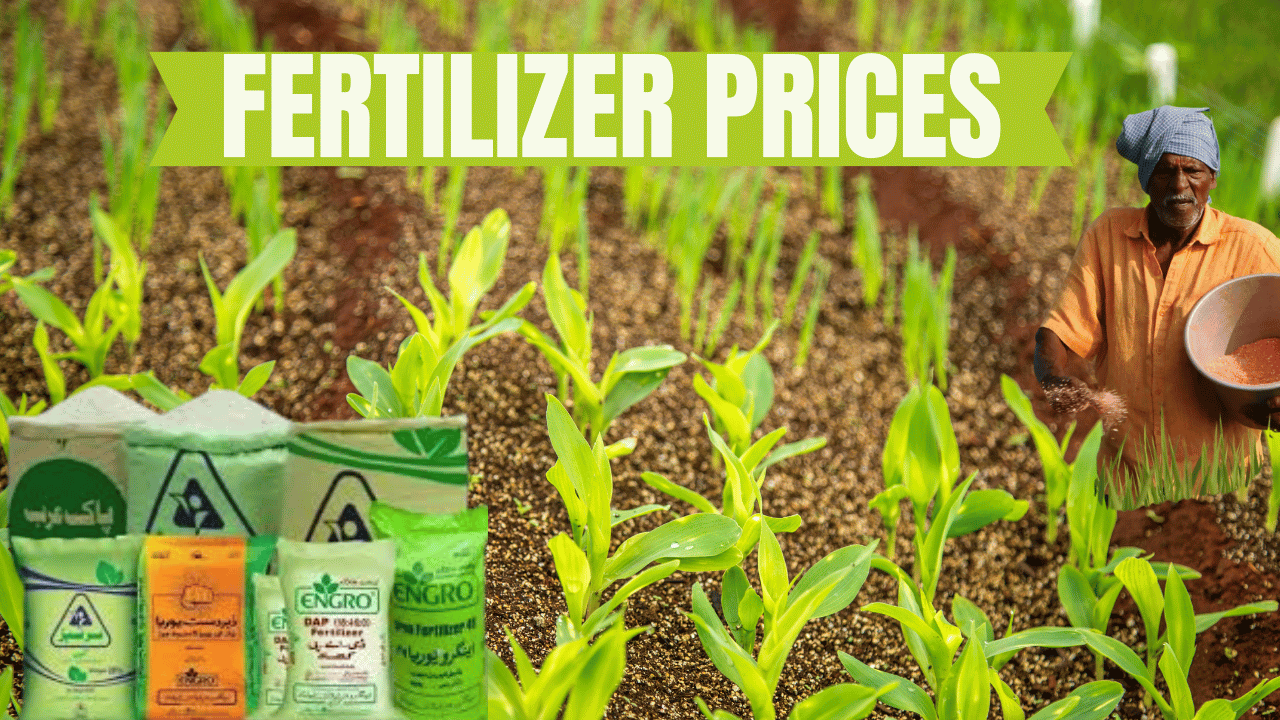Fertilizer Prices
Fertilizer prices vary based on market demand, supply, and government policies. Farmers must stay updated with price trends to manage their budgets effectively. Below are some of the key fertilizers and their price trends: Urea fertilizer is the most widely used nitrogen-based fertilizer. It contains a high nitrogen percentage, essential for leaf growth and chlorophyll production. Potash fertilizers, on the other hand, enhance root strength and increase resistance to pests and diseases. DAP (Diammonium Phosphate) is a phosphorus-rich fertilizer that supports root and seed development, particularly useful for wheat, maize, and cotton.

Fertilizer Prices
| Fertilizers | Minimum Price | Maximum Price |
|---|---|---|
| Sona Urea | Rs. 4300 | Rs. 4600 |
| Engro Urea | Rs. 4350 | Rs. 4550 |
| Engro DAP | Rs. 11200 | Rs. 11600 |
| FFC DAP | Rs. 11500 | Rs. 11900 |
| Sarsabz DAP | Rs. 11450 | Rs. 11800 |
| Sona Urea Granular | Rs. 4400 | Rs. 4650 |
| Engro NP plus | Rs. 6000 | Rs. 6500 |
| Pak Arab Gawara | Rs. 4100 | Rs. 4300 |
| Zabardast Urea | Rs. 5200 | Rs. 5500 |
| Sarsabz Can Gawara | Rs. 4150 | Rs. 4400 |
| Sarsabz NP(nitro) | Rs. 7300 | Rs. 7500 |
| Zarkhez Plus | Rs. 9200 | Rs. 9500 |
| FFBL DAP | Rs. 11500 | Rs. 12100 |
| Sona Zinc 3kg | Rs. 2100 | Rs. 2300 |
| FMC SOP granular | Rs. 11500 | Rs. 12000 |
| Zarkhez Khas SOP | Rs. 10500 | Rs. 11200 |
| Powder SOP | Rs. 10100 | Rs. 10500 |
| BabarSher DAP | Rs. 11400 | Rs. 11800 |
| Ammonium Sulphate | Rs. 4100 | Rs. 4500 |
| Power Potash 25kg | Rs. 12500 | Rs. 12800 |
| Engro Zorawar | Rs. 14000 | Rs. 14500 |
| Engro SOP | Rs. 11500 | Rs. 11900 |
Urea Fertilizer Price in Pakistan
| Urea Khad | Minimum Price | Maximum Price |
|---|---|---|
| Sona Urea (pearl) | Rs. 4300 | Rs. 4600 |
| Sona Urea 25kg | Rs. 2150 | Rs. 2300 |
| Sona Urea (neem coated) | Rs. 4250 | Rs. 4550 |
| Sona Urea Granular | Rs. 4400 | Rs. 4650 |
| Engro Urea | Rs. 4350 | Rs. 4550 |
| Zabardast Urea | Rs. 5200 | Rs. 5500 |
| Sarsabz Urea | Rs. 4450 | Rs. 4700 |
| BS/PFL Urea | Rs. 4500 | Rs. 4650 |
| Babar Sher Urea | Rs. 4300 | Rs. 4500 |
| Imported Urea | Rs. 4400 | Rs. 4600 |
DAP Fertilizer Price in Pakistan
| DAP Khad | Minimum Price | Maximum Price |
|---|---|---|
| Engro DAP | Rs. 11200 | Rs. 11600 |
| Sona DAP | Rs. 11250 | Rs. 11650 |
| Sona DAP (25kg) | Rs. 5625 | Rs. 5825 |
| FFC DAP | Rs. 11500 | Rs. 11900 |
| Sarsabz DAP | Rs. 11450 | Rs. 11800 |
| Sona Boron DAP | Rs. 12100 | Rs. 12500 |
| FFBL DAP | Rs. 11500 | Rs. 12100 |
| Babar Sher DAP | Rs. 11400 | Rs. 11800 |
- Urea Fertilizer Price: Enhances plant growth by increasing chlorophyll production.
- Potash Fertilizer Price: Strengthens plant roots and improves drought resistance.
- DAP Fertilizer Price in Pakistan: Supports seed and root development, ideal for key crops.
- Engro & Fauji Fertilizer Share Price: Influence the overall market trends and pricing.
- Ammonium Nitrate Fertilizer Price in Pakistan: Known for quick-release nitrogen for rapid growth.
- SOP Fertilizer Price in Pakistan: Beneficial for high-value crops, enhancing taste and shelf life.
- NP Fertilizer Price in Pakistan: A balanced mix of nitrogen and phosphorus for improved yield.
Types of Fertilizers and Their Benefits
Fertilizers are categorized based on their nutrient composition. Farmers should choose fertilizers based on their crop requirements and soil condition.
Nitrogen-based fertilizers such as urea and ammonium nitrate are essential for promoting healthy foliage and plant development. Phosphorus-based fertilizers like DAP support strong root growth and improve flowering. Potassium-based fertilizers, including SOP, help plants build strong stems and resist diseases. Organic fertilizers, such as compost and manure, enhance soil structure and microbial health over time. Synthetic fertilizers, like ammonium sulfate, deliver rapid nutrient uptake for immediate results.
- Nitrogen-Based Fertilizers: Best for leafy crops like wheat and maize.
- Phosphorus-Based Fertilizers: Essential for flowering plants and root crops.
- Potassium-Based Fertilizers: Strengthen plant immunity and boost drought resistance.
- Organic Fertilizers: Improve soil quality and long-term sustainability.
- Synthetic Fertilizers: Provide quick nutrient supply for fast-growing crops.
How to Choose the Right Fertilizer?
Selecting the appropriate fertilizer is crucial for crop health and productivity. Farmers must consider several factors before applying fertilizers.
Soil testing helps determine existing nutrient levels, ensuring the right fertilizer is applied. Different plants have unique nutrient requirements, and choosing an organic or synthetic option depends on the farmer’s long-term sustainability goals. Additionally, excessive use of chemical fertilizers can degrade soil health, so maintaining a balance is key.
- Soil Testing: Determines the soil’s nutrient deficiency.
- Crop-Specific Nutrients: Different plants require unique fertilizer blends.
- Organic vs. Synthetic: Organic options are eco-friendly, while synthetic fertilizers act fast.
- Environmental Impact: Overuse of chemical fertilizers may lead to soil degradation.
Natural vs. Artificial: The Two Primary Types of Plant Nutrients
Gardeners must decide between natural (organic) and artificial (synthetic) plant nutrients. Natural options, such as compost or animal manure, originate from living sources. They decompose gradually, enriching the soil and nourishing plants steadily. In contrast, artificial nutrients are laboratory-made and deliver rapid nourishment.
| Category | Natural Fertilizers | Artificial Fertilizers |
|---|---|---|
| Source | Animal byproducts, decayed plants | Industrially processed chemicals |
| Nutrient Release | Gradual, enhances soil health | Immediate, short-term effect |
| Environmental Impact | Minimal harm, sustainable | Higher risk of contamination |
| Cost & Usage | Variable, long-term benefits | Fast results, may need repeated use |
“A thriving garden depends on harmony—not just nourishment, but time and care.”
Many growers combine natural and artificial fertilizers. Natural options build soil vitality, while artificial ones spur rapid growth. Choosing wisely depends on soil tests, plant varieties, and gardening objectives.
Current Trends in Fertilizer Market
The global fertilizer market is continuously evolving due to supply-demand fluctuations, new farming techniques, and economic conditions.
Engro and Fauji fertilizer prices often dictate market movements. There is also increasing adoption of zinc-based fertilizers due to widespread soil deficiencies. Balanced fertilizers like NP and SOP are gaining popularity among farmers for sustainability. Organic farming is also growing, leading to higher demand for compost and natural fertilizers.
- Market Prices Fluctuate: Influenced by global demand and supply factors.
- Zinc-Based Fertilizers: More farmers are using them due to soil deficiencies.
- Organic Fertilizers: Demand is rising due to sustainable farming trends.
Best Practices for Fertilizer Application
Proper fertilizer application ensures optimal plant growth and minimizes wastage. Timing, dosage, and method of application play a significant role in effectiveness.
Applying fertilizers at the correct plant growth stage is critical. Overuse of fertilizers can damage plants and soil, while a combination of organic and synthetic fertilizers can improve soil health. Precision farming techniques such as drip irrigation enhance efficiency by reducing nutrient wastage.
- Apply at Correct Timing: Ensures maximum nutrient absorption.
- Follow Recommended Dosages: Prevents soil toxicity and plant damage.
- Combine Organic & Synthetic Fertilizers: Enhances soil fertility over time.
- Use Precision Farming: Reduces nutrient loss and maximizes efficiency.
Understanding NPK Ratios in Fertilizers
Fertilizers come with different NPK (Nitrogen, Phosphorus, Potassium) ratios, which indicate their nutrient content. Understanding these ratios helps farmers select the best fertilizer for their crops.
Nitrogen promotes healthy leaves and overall plant growth, phosphorus strengthens roots and flowers, and potassium supports disease resistance and plant vigor. The right NPK ratio depends on crop requirements; for example, a 10-10-10 blend provides balanced nutrients, while a 20-10-10 ratio is better for leafy greens.
- 10-10-10: Suitable for general gardening and balanced plant nutrition.
- 5-20-5: Ideal for root crops such as carrots and onions.
- 20-10-10: High nitrogen content, perfect for leafy vegetables.
Eco-Friendly Fertilizer Choices
With environmental concerns rising, farmers are turning to eco-friendly fertilizers that promote soil health while reducing pollution.
Organic fertilizers such as compost, manure, and biofertilizers improve soil fertility naturally. Controlled-release fertilizers prevent excessive nutrient runoff into water bodies. Crop rotation practices help maintain soil health by balancing nutrient use.
- Use Organic Fertilizers: Reduces soil contamination.
- Apply Controlled-Release Fertilizers: Prevents over-fertilization issues.
- Practice Crop Rotation: Helps maintain nutrient balance in the soil.
Common Fertilization Mistakes to Avoid
Many farmers unknowingly make mistakes while applying fertilizers, leading to poor crop yields and soil damage. Understanding these mistakes helps improve efficiency. Over-fertilization can cause leaf burns and soil toxicity, leading to reduced plant productivity. Applying fertilizers at the wrong time, such as when plants are dormant, wastes nutrients. Ignoring soil pH levels can reduce nutrient absorption and effectiveness.
| Season | Correct Timing | Avoid |
|---|---|---|
| Spring | Early growth stages | Before last frost |
| Summer | Mid-summer for perennials | Extreme heat |
| Fall | Before first frost | After leaf drop |
- Avoid Over-Fertilization: Prevents soil toxicity and plant damage.
- Time Application Properly: Enhances nutrient utilization.
- Check Soil pH Levels: Ensures proper nutrient uptake by plants.
Link to Detailed Official Price Lists :- Engro Fertilizer
Conclusion
Choosing the right fertilizer begins with understanding your garden’s unique needs, as there is no single solution that works for every plant or soil type. Conducting a soil test is the most reliable way to identify which nutrients are lacking, allowing you to make an informed decision. Some plants, such as roses, thrive with phosphorus-rich fertilizers, while vegetables often require a balanced NPK (nitrogen, phosphorus, potassium) blend to support healthy growth. Organic fertilizers, like compost or manure, enhance soil structure and fertility over time, making them ideal for long-term garden health. In contrast, synthetic fertilizers provide rapid nutrient delivery, which can be beneficial for quick fixes or high-demand growing phases. Environmental impact is another key consideration—organic and slow-release options minimize runoff risks, while excessive synthetic use can contribute to pollution.

